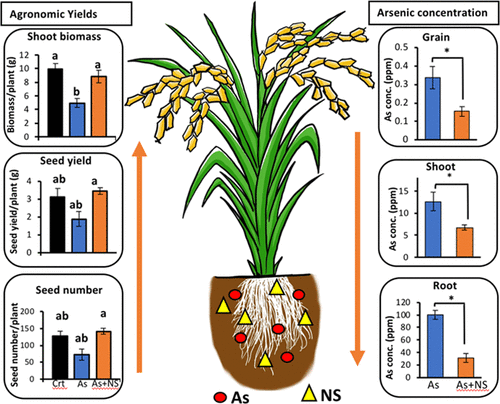当前位置:
X-MOL 学术
›
Environ. Sci. Technol.
›
论文详情
Our official English website, www.x-mol.net, welcomes your
feedback! (Note: you will need to create a separate account there.)
Nanoscale Sulfur Improves Plant Growth and Reduces Arsenic Toxicity and Accumulation in Rice (Oryza sativa L.)
Environmental Science & Technology ( IF 10.8 ) Pub Date : 2021-09-27 , DOI: 10.1021/acs.est.1c05495 Ahmed G Meselhy 1, 2 , Sudhir Sharma 1 , Zhi Guo 1, 3 , Gurpal Singh 1 , Haiyan Yuan 1, 4 , Rudra D Tripathi 5 , Baoshan Xing 1 , Craig Musante 6 , Jason C White 6 , Om Parkash Dhankher 1
Environmental Science & Technology ( IF 10.8 ) Pub Date : 2021-09-27 , DOI: 10.1021/acs.est.1c05495 Ahmed G Meselhy 1, 2 , Sudhir Sharma 1 , Zhi Guo 1, 3 , Gurpal Singh 1 , Haiyan Yuan 1, 4 , Rudra D Tripathi 5 , Baoshan Xing 1 , Craig Musante 6 , Jason C White 6 , Om Parkash Dhankher 1
Affiliation

|
Rice is known to accumulate arsenic (As) in its grains, posing serious health concerns for billions of people globally. We studied the effect of nanoscale sulfur (NS) on rice seedlings and mature plants under As stress. NS application caused a 40% increase in seedling biomass and a 26% increase in seed yield of mature plants compared to untreated control plants. AsIII exposure caused severe toxicity to rice; however, coexposure of plants to AsIII and NS alleviated As toxicity, and growth was significantly improved. Rice seedlings treated with AsIII + NS produced 159 and 248% more shoot and root biomass, respectively, compared to plants exposed to AsIII alone. Further, AsIII + NS-treated seedlings accumulated 32 and 11% less As in root and shoot tissues, respectively, than the AsIII-alone treatment. Mature plants treated with AsIII + NS produced 76, 110, and 108% more dry shoot biomass, seed number, and seed yield, respectively, and accumulated 69, 38, 18, and 54% less total As in the root, shoot, flag leaves, and grains, respectively, compared to AsIII-alone-treated plants. A similar trend was observed in seedlings treated with AsV and NS. The ability of sulfur (S) to alleviate As toxicity and accumulation is clearly size dependent as NS could effectively reduce bioavailability and accumulation of As in rice via modulating the gene expression activity of As transport, S assimilatory, and glutathione synthesis pathways to facilitate AsIII detoxification. These results have significant environmental implications as NS application in agriculture has the potential to decrease As in the food chain and simultaneously enable crops to grow and produce higher yields on marginal and contaminated lands.
中文翻译:

纳米级硫改善植物生长并降低水稻 (Oryza sativa L.) 中砷的毒性和积累
众所周知,大米会在其谷物中积累砷 (As),给全球数十亿人带来严重的健康问题。我们研究了纳米硫 (NS) 在砷胁迫下对水稻幼苗和成熟植株的影响。与未处理的对照植物相比,NS 应用导致幼苗生物量增加 40%,成熟植物的种子产量增加 26%。AsIII 暴露对水稻造成严重毒性;然而,植物与 AsIII 和 NS 的共同暴露减轻了 As 毒性,并且显着改善了生长。与单独暴露于 AsIII 的植物相比,用 AsIII + NS 处理的水稻幼苗分别产生了 159% 和 248% 的地上部和根部生物量。此外,与单独的 AsIII 处理相比,AsIII + NS 处理的幼苗在根和芽组织中积累的 As 分别减少了 32% 和 11%。用 AsIII + NS 处理的成熟植物产生 76,与 AsIII 相比,干枝生物量、种子数和种子产量分别增加 110% 和 108%,根、枝条、旗叶和籽粒中累积的总砷分别减少 69%、38%、18% 和 54% -单独处理的植物。在用 AsV 和 NS 处理的幼苗中观察到类似的趋势。硫 (S) 减轻砷毒性和积累的能力显然取决于大小,因为 NS 可以通过调节砷转运、硫同化和谷胱甘肽合成途径的基因表达活性来促进砷解毒,从而有效降低水稻中砷的生物利用度和积累.
更新日期:2021-10-19
中文翻译:

纳米级硫改善植物生长并降低水稻 (Oryza sativa L.) 中砷的毒性和积累
众所周知,大米会在其谷物中积累砷 (As),给全球数十亿人带来严重的健康问题。我们研究了纳米硫 (NS) 在砷胁迫下对水稻幼苗和成熟植株的影响。与未处理的对照植物相比,NS 应用导致幼苗生物量增加 40%,成熟植物的种子产量增加 26%。AsIII 暴露对水稻造成严重毒性;然而,植物与 AsIII 和 NS 的共同暴露减轻了 As 毒性,并且显着改善了生长。与单独暴露于 AsIII 的植物相比,用 AsIII + NS 处理的水稻幼苗分别产生了 159% 和 248% 的地上部和根部生物量。此外,与单独的 AsIII 处理相比,AsIII + NS 处理的幼苗在根和芽组织中积累的 As 分别减少了 32% 和 11%。用 AsIII + NS 处理的成熟植物产生 76,与 AsIII 相比,干枝生物量、种子数和种子产量分别增加 110% 和 108%,根、枝条、旗叶和籽粒中累积的总砷分别减少 69%、38%、18% 和 54% -单独处理的植物。在用 AsV 和 NS 处理的幼苗中观察到类似的趋势。硫 (S) 减轻砷毒性和积累的能力显然取决于大小,因为 NS 可以通过调节砷转运、硫同化和谷胱甘肽合成途径的基因表达活性来促进砷解毒,从而有效降低水稻中砷的生物利用度和积累.











































 京公网安备 11010802027423号
京公网安备 11010802027423号